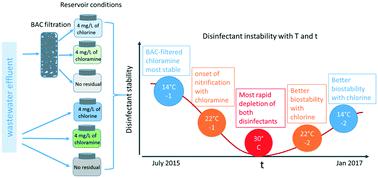当前位置:
X-MOL 学术
›
Environ. Sci.: Water Res. Technol.
›
论文详情
Our official English website, www.x-mol.net, welcomes your feedback! (Note: you will need to create a separate account there.)
Effects of BAC-filtration, disinfection, and temperature on water quality in simulated reclaimed water distribution systems
Environmental Science: Water Research & Technology ( IF 5 ) Pub Date : 2020-09-16 , DOI: 10.1039/d0ew00581a Ni Zhu 1, 2, 3, 4 , Sudeshna Ghosh 1, 2, 3, 4 , Laurel Strom 4, 5, 6 , Amy Pruden 1, 2, 3, 4 , Marc A. Edwards 1, 2, 3, 4
Environmental Science: Water Research & Technology ( IF 5 ) Pub Date : 2020-09-16 , DOI: 10.1039/d0ew00581a Ni Zhu 1, 2, 3, 4 , Sudeshna Ghosh 1, 2, 3, 4 , Laurel Strom 4, 5, 6 , Amy Pruden 1, 2, 3, 4 , Marc A. Edwards 1, 2, 3, 4
Affiliation

|
The distinct characteristics of reclaimed versus potable water have important implications for design and operation of reclaimed water distribution systems (RWDSs). Here we operated six simulated RWDSs in parallel to determine the effects of feed water treatment (with and without biologically-active carbon (BAC) filtration) and residual disinfectants (chlorine, chloramine, or no residual) on the distributed water quality. Following a six-month acclimation period, the experimental conditions were implemented over 2 years of operation, with a temperature regime of 14 °C → 22 °C → 30 °C → 22 °C → 14 °C imposed to simulate seasonal variation. Comprehensive water chemistry profiling and microbial sampling were conducted over a range of water ages (0 d, 1 d, 2.5 d and 5 d) along the RWDSs at each temperature phase. When ≥22 °C, RWDSs became more vulnerable to deterioration of water quality due to nitrification, as evidenced by accelerated chloramine decay and increased relative abundance of nitrifier genera and functional genes. Contrary to conventional experience in potable water distribution, chlorine generally became more persistent than chloramine from the first 22 °C phase onwards. Enhanced persistence of chlorine was accompanied by increased biological stability (i.e., lower cell counts and reduced dissolved oxygen demand). BAC filtration initially improved water quality (i.e., lower total organic carbon and biomass, longer persistence of disinfectants), but benefits diminished over long term distribution system operation. Taxonomic and functional metagenomic profiles revealed that chlorine had the strongest selective effect compared to both chloramine and no residual, particularly for the unfiltered condition. The long-term operation strategy employed here enabled evaluation of distribution system management practices and their interactive effects as the RWDSs experienced temperature shifts and aged.
中文翻译:

BAC过滤,消毒和温度对模拟再生水分配系统中水质的影响
回收与饮用水对再生水分配系统(RWDSs)的设计和运行具有重要意义。在这里,我们并行操作了六个模拟的RWDS,以确定给水处理(有无生物活性炭(BAC)过滤)和残留消毒剂(氯,氯胺或无残留)对分布水质的影响。经过六个月的适应期后,在2年的运行条件下实施了实验条件,并采用14°C→22°C→30°C→22°C→14°C的温度范围来模拟季节性变化。在每个温度阶段,沿RWDS在一定的水龄范围(0 d,1 d,2.5 d和5 d)内进行了全面的水化学分析和微生物采样。≥22°C时 由于硝化作用加速,硝化剂属和功能基因的相对丰度增加,RWDSs更容易因硝化而导致水质恶化。与饮用水分配的常规经验相反,从最初的22°C开始,氯通常比氯胺更具持久性。氯的持久性增强,同时生物稳定性增强(即减少细胞数并减少溶解氧需求。BAC过滤最初改善了水质(即,降低了总有机碳和生物量,延长了消毒剂的持久性),但在长期的分配系统运行中,其收益却有所减少。分类学和功能性宏基因组学分析表明,与氯胺相比,氯具有最强的选择性作用,并且没有残留,特别是对于未过滤条件。当RWDS经历温度变化和老化时,此处采用的长期操作策略可评估配电系统管理实践及其交互作用。
更新日期:2020-09-24
中文翻译:

BAC过滤,消毒和温度对模拟再生水分配系统中水质的影响
回收与饮用水对再生水分配系统(RWDSs)的设计和运行具有重要意义。在这里,我们并行操作了六个模拟的RWDS,以确定给水处理(有无生物活性炭(BAC)过滤)和残留消毒剂(氯,氯胺或无残留)对分布水质的影响。经过六个月的适应期后,在2年的运行条件下实施了实验条件,并采用14°C→22°C→30°C→22°C→14°C的温度范围来模拟季节性变化。在每个温度阶段,沿RWDS在一定的水龄范围(0 d,1 d,2.5 d和5 d)内进行了全面的水化学分析和微生物采样。≥22°C时 由于硝化作用加速,硝化剂属和功能基因的相对丰度增加,RWDSs更容易因硝化而导致水质恶化。与饮用水分配的常规经验相反,从最初的22°C开始,氯通常比氯胺更具持久性。氯的持久性增强,同时生物稳定性增强(即减少细胞数并减少溶解氧需求。BAC过滤最初改善了水质(即,降低了总有机碳和生物量,延长了消毒剂的持久性),但在长期的分配系统运行中,其收益却有所减少。分类学和功能性宏基因组学分析表明,与氯胺相比,氯具有最强的选择性作用,并且没有残留,特别是对于未过滤条件。当RWDS经历温度变化和老化时,此处采用的长期操作策略可评估配电系统管理实践及其交互作用。



























 京公网安备 11010802027423号
京公网安备 11010802027423号